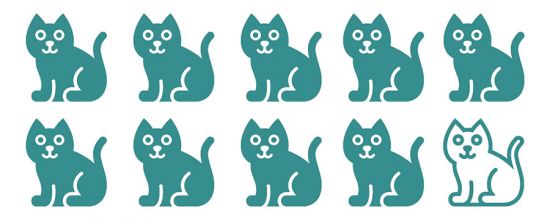
Is your cat less active now simply because of old age, or could they be suffering from osteoarthritis?
In this article we are going to answer 5 questions:
- What is osteoarthritis and how common is it in cats?
- Why is it important to identify osteoarthritis in cats as early as possible?
- How to identify if your cat has osteoarthritis?
- What treatments are there for osteoarthritis?
- What other ways can you improve your cat’s quality of life if it has osteoarthritis?
What is osteoarthritis and how common is it in cats?
Osteoarthritis (OA) also known as Degenerative Joint Disease (DJD) is the most common form of arthritis, and it involves the degeneration of cartilage, fluid and structures in the joints that leads to chronic inflammation, pain and reduced mobility.
The evidence shows that osteoarthritis is very common in cats. A study published in 2002 used x-rays to examine the joints of 100 cats over the age of 12 and found joint disease in 90 of them! Another study from 2010, looked at 100 cats from all different age groups and found similar 92% of cats with OA affecting leg joints or the spine. It also showed a strong association between age and likelihood of OA.

9 out of 10 cats over the age of 12 were found to have joint disease
Why it is important to identify osteoarthritis in cats as early as possible?
Early identification of OA is really important because untreated pain can not only greatly reduce the quality of life of your pet but can also cause brain decline and other detrimental effects such as weight gain.
Early therapy and treatment can not only slow progression of the disease but also reduce the discomfort and pain that your cat may be suffering from. Awareness of the disease also enables you to adapt your cat’s environment to their reduced movement and further decrease unnecessary stress on joints.
To be blunt, this is a common disease that causes pain, and none of us want out pets suffering! Therefore, it’s very important that we are fully aware of the disease and how to identify it.
How to identify if your cat has osteoarthritis?
Cats are great at hiding any weakness or pain, a trait inherited from their wild cousins, so it’s very difficult to understand exactly how they feel. We might think they are just a bit more lazy/sleepy as they get older but perhaps, they are actually in a lot of discomfort!
We do not always see limping or lameness in cats, because as predators, they do not show injury as a matter of survival - they have a tendency to hide their pain. They are also light and in the home environment, able to adapt. In addition, OA in cats tends to occur bilaterally- that means in both elbows, both hips, both shoulders and as such, they may be equally sore on both sides. As cat owners, we are often not aware of the disease and therefore we do not notice the symptoms, nor report them to their vet.
Let’s fix that last part, and make sure we all know what to look for. The best way to identify possible osteoarthritis is for owners to be aware of subtle behavioural changes. By observing your cat, you may see early indications of joint pain and discomfort that are normally hidden in an examination.
Signs to look out for include:
- Jumping up
Hesitation, does not clear jump, uses ‘arms’ to pull the body up - Jumping down
Hesitation, makes small jumps down instead of one big one, reaches downs slowly before jumping - Climbing up stairs
bunny hop technique with both back legs together, stops for rests - Climbing downstairs
One stair at a time, holds body at angle to the side, stops for rests - Decreased grooming
- Difficulty getting up, standing, or walking
- Sensitivity (or vocalisation) to touch
- Changes in behaviour (eg aggression or withdrawn)
- Struggle to move in and out of the litter box or changes in toileting habits
- Hesitant to play, frequently stopping, or reduced exercise tolerance
- Increased sleeping time or hiding more, unwilling to explore
If you have noticed any behavioural changes such as those listed above, it might be time to take your cat to the vet for an orthopaedic physical exam. It is very helpful to take some home videos of your cat standing and walking or jumping prior to consultation, as they will likely hide their symptoms from the vet too!

What are the treatments available for osteoarthritis?
Prescribed treatments and therapy can vary depending on the severity of the condition, but it might include long-term prescription or pain medication, physiotherapy, injections, supplements, exercise, and weight loss. Providing oral medication can be difficult for reluctant pets and forcing the issue can upset the human-animal bond between pets and their pawrents. Also, selection of the best treatment must be made with the consideration of other potential problems associated with old age including kidney or liver problems.
That’s why at Paws in Motion we really recommend the Assisi loop, which is a non-pharmaceutical, non-invasive, anti-inflammatory device that can be used to alongside or as an alternative to oral medication to manage pain and inflammation. The device can be put underneath your cat’s favourite sleeping spot. Turn it on when the cat is sleeping, and the treatment will automatically stop after 15min. This is especially great news for owners who have difficult cats that are hard to pill and medicate.
If your cat is happy to be handled, physiotherapy can also be considered. We use manual therapies and machines (such as photobiomodulation) to help control pain and inflammation. To know more, please refer to our blog, "Really? You can do physiotherapy with a cat??"

| Oral Medication | Assisi Loop | |
|---|---|---|
| Proven to reduce pain | Yes | Yes |
| Proven to reduce inflammation | Yes | Yes |
| Totally stress free for cat owner | No | Yes |
| Totally stress free for cat | No | Yes |
| No risk of complications with other age-related disease | No | Yes |
What else can you do to improve your cat’s quality of life?
Here are some other ways to adapt your cat’s environment to provide a 5 - star home and reduce the effects of osteoarthritis.
- Help them reach their favourite places by strategically placing boxes and furniture to be used as steps.
- Provide plenty of cosy, well-padded beds in safe and warm places for hiding.
- Make sure food and water are easily accessible to them such as placing their bowls on a small box to reduce their reach.
- Ensure the sides of their litter tray aren’t too tall, or provide a step so they can climb in and out easily.
References
- Hardie EM, Roe SC, Martin FR. Radiographic evidence of degenerative joint disease in geriatric cats: 100 cases (1934-1997). J Am Vet Med Assoc. (2002) 220:628–32. 10.2460/javma.2002.220.628
- Lascelles BD, Henry JB, Brown J, Robertson I, Sumrell AT, Simpson W, Wheeler S, Hansen BD, Zamprogno H, Freire M. et al. Cross-sectional study of the prevalence of radiographic degenerative joint disease in domesticated cats. Vet Surg. 2010;39(5):535–544. doi: 10.1111/j.1532-950X.2010.00708.x.
相關產品
Assisi Loop Lounge®消炎治療床
HK$ 8880
Assisi Loop®消炎儀器
HK$ 2880
This site is protected by reCAPTCHA and the Google Privacy Policy and Terms of Service apply.








